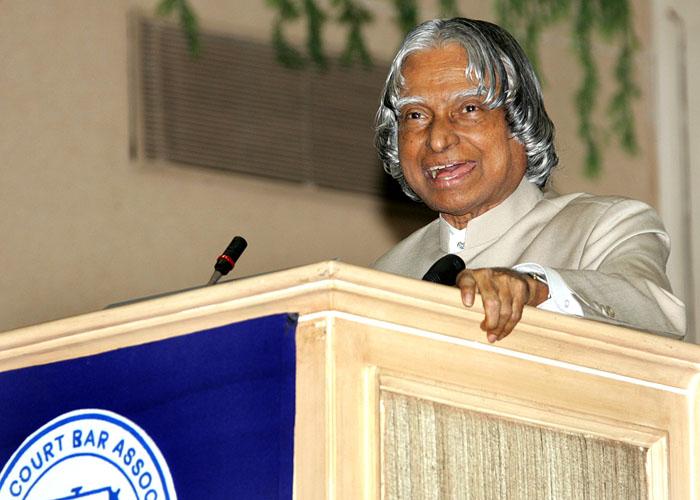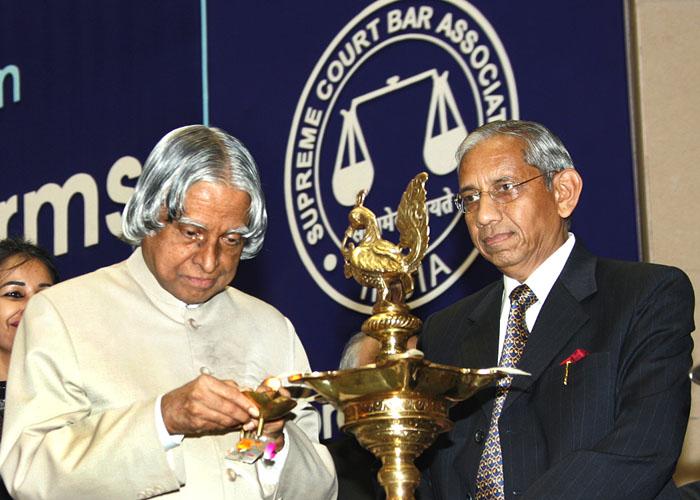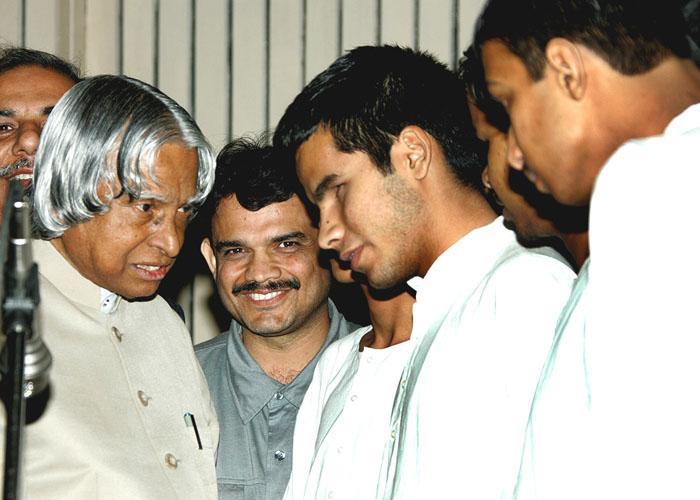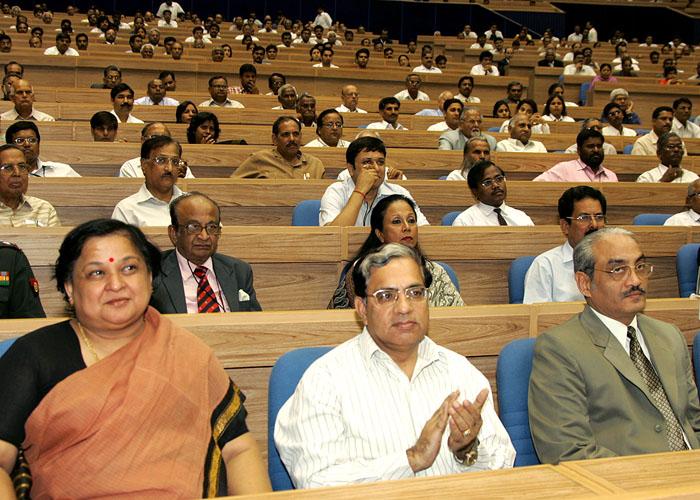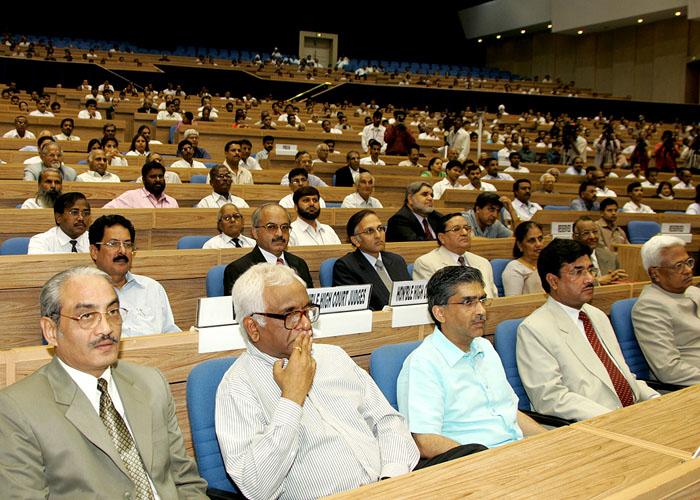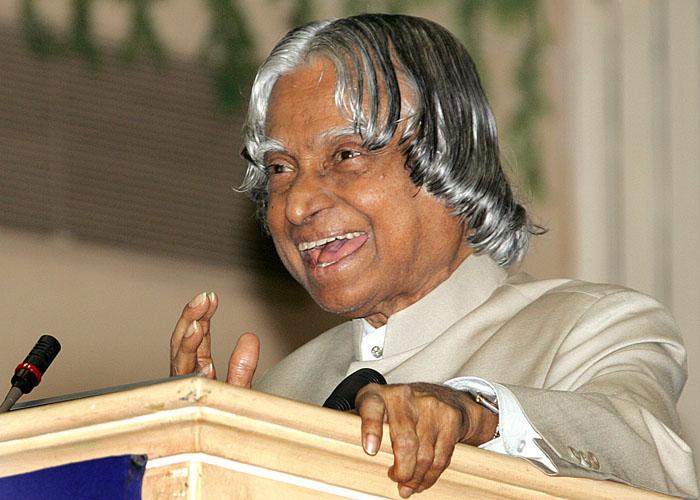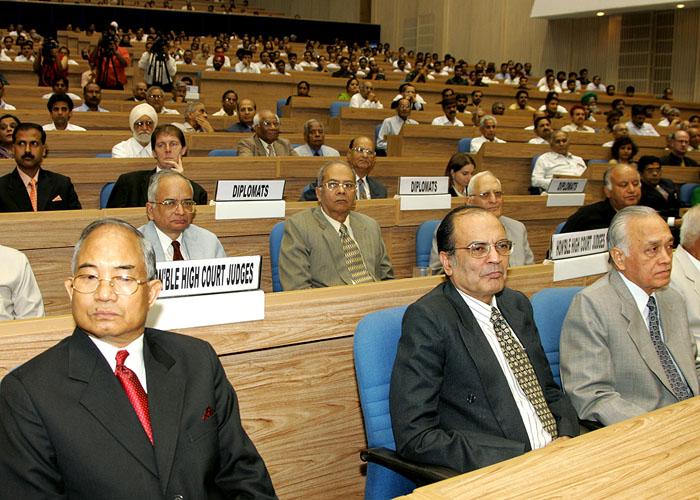Address at the Inauguration of the All India Seminar on Judicial Reforms With Special Reference to Arrears of Court Cases
Rashtrapati Bhavan, New Delhi : 29-04-2005
Evolution: National Litigation Pendency Clearance Mission
I am delighted to participate in the Inauguration of the All India Seminar on Judicial Reforms with Special Reference to Arrears of Court Cases being organized by the Supreme Court Bar Association. I greet the Hon?ble Chief Justice of India, Hon?ble Justices of Supreme Court and High Courts, distinguished legal personalities and other participants.
Importance of speedy justice
In a developing economy, there is an urgent need to implement nationally relevant and important projects in a time bound manner. While the Courts are the guardians to protect the projects from an onslaught from unscrupulous individuals or groups, the Courts also have a responsibility to ensure that honest implementations are not impeded by unsustainable or motivated litigations. This dual role of the judiciary places enormous responsibility on the shoulders of the Courts and the nation?s development is equally dependent on the dynamism and the innovativeness of the judicial system. Hence, there is an urgent need to ensure that no justice is delayed and the situation existing today is remedied. Though I have cited an example from the projects of the national initiative?s point of view, this is equally valid even for the litigations that concerns individual citizens and organisations as well. In this respect, the Seminar on Judicial Reforms that you are organizing today is a very important event which provides an opportunity for Hon?ble Judges, lawyers and other experts to work together and recommend an action plan for the changes which are needed in our legal system in an integrated way to provide a speedy justice delivery system to our citizens. I would like to discuss with this audience the topic of ?Evolution: National Litigation Pendency Clearance Mission?.
Causes leading to delay
I was studying the data on the pending cases in the Supreme Court, High Courts and District Courts during the period 1995 to 2004. I find the number of pending cases in the Supreme Court has come down from 36,000 in 1995 to 30,000 in the year 2004. This is a good sign and shows the result of consistent efforts. There are twenty four judges in the strength of Supreme Court at present. If all of them decide to take up a thousand additional cases to be cleared during two years by working two additional hours on all working days and on Saturdays, I am sure by the year 2007; pending cases can be minimized substantially. Of course, the quality of the judgment cannot be compromised. This will set up a beautiful role model for all the other courts to follow. But their problems are heavy and new solutions have to be found for them.
When I look at the data of pending cases in the High Courts, I find that it has increased from 3 million to 3.4 million and in the District Courts; the pending cases have increased from 20.6 million to 23.4 million. This means on an average more than 4% of our population are affected by the prolongation of litigations. Particularly, rural people?s quality of life gets affected by enormity of litigations. This is definitely a matter of serious concern for all of us. This can be corrected by only through a society that has a high value system, concern for others and good governance by people who themselves are beacons of virtue and who can be emulated as role models.
There are many instances in the country where the Court cases have not been settled for more than ten years. I have received reports pointing out that certain cases have been pending for over three decades. The causes attributed for this delay are (i) Inadequate number of Courts (ii) Inadequate number of judicial officers (iii) Judicial officers not fully equipped to tackle cases involving specialized knowledge (iv) Dilatory tactics by the litigants and their lawyers who seek frequent adjournments and delay in filing documents and (v) role of administrative staff of the Court. Can we remedy this situation? How? I would like this Seminar to discuss various possibilities to reduce the Pendency of court cases.
1. Dispute resolution through human touch
I would like to share my experiences in Rameswaram. Almost every day after the evening namaz my father used to come back and sit outside. Each day about 10 to 20 families or at times individuals would come to my father and tell their problems on land and house disputes, marriage conflicts and issues involving forsaking of elderly parents and get solutions. They will get a solution within two or three days. In a similar way, my mother used to meet many womenfolk on Fridays. They will seek her advice. My elder brother himself was Panchayat Court President. The court had five good human beings from various walks of life and with one State Government representative. In those days, caste system was not visible at all. I used to see many disputes of human life being settled in our own rural environment. Only if the disputes are not settled at these two levels they used to resort to higher courts. After 1970s, all these systems with human touch vanished and most of these disputes are directly piling up in courts. I feel, since the Panchayat environment is emerging in rural areas, the judicial system at the Panchayat level also can take a shape with the same type of human touch. This may reduce the load in our courts. It is generally said that ?law is somewhere and justice is somewhere else?. In the rural judicial system justice is always with the truth.
2. Reinforcement of Lokadalats
Lokadalats are already handling certain types of cases. More Lokadalats can be constituted for hearing and settling cases which are having similar characteristics. For example, there is a Lokadalat for settling military pension cases which has worked effectively in settling a number of pension complaints. Likewise, certain number of motor accidents claims by victims has been settled by Lokadalats. The settlement of disputed electricity bills in Delhi is also taking place through Lokadalats. The legal experts assembled here can consider and recommend the areas which can be looked after by Lokadalats in the States and the Centre so that large number of cases can be entrusted to this legal machinery for settlement. However, we should guard the Lokadalats from the influence of local elements in the semi-urban and rural areas. Based on the experience, we have to constitute and empower additional Lokadalats which can solve disputes involving state and central government units. This situation will further reduce the number of pending cases at District and High Court level.
3. Evolution of a National Litigation Pendency Clearance Mission:
When it is said, High Courts have a pendency of 3.4 million and district courts 23.4 million the following actions are very important:
a) Classification of cases with age analysis
b) Identifying how many cases have become deadwoods, for the reasons generations will not be interested in pursuing the same.
c) Computerization takes into account a) & b) ? and identifies the active cases. Perhaps just half of the cases or more will still be pending?
d) Evolution of National Litigation Pendency Clearance Mission.
Fortunately, India had a number of successful mission mode programmes in agriculture, nuclear technology, defence research, space technology and recently in IT sectors. We can use the experiences from these programmes and evolve a ?Judiciary Programme Management Group? with empowered team of IT power for such a task.
4. Alternative dispute redressal mechanism
Dispute arising with telecom authorities and many a contracts between individuals and the Governments, as also between corporates have been settled through arbitration. This can be extended, wherever an element of contract is perceived. We need innovative tools for settlement of disputes that are capable of functioning transparently, consistent with the rules of natural justice. Here the appointment of trained arbitrators, who can act with speed, becomes important catalyst in settling the disputes without jeopardizing the genuine interest of the concerned parties. This type of contract arbitration has to be acknowledged by the courts and encouraged. This will further reduce the accumulation of fresh cases.
5. Potential of e-Judiciary
The judgments of the Supreme Court and some High Courts are now available in the internet. This step has considerably relieved the agony of the litigants and also enables others to use these judgments in their areas of interest. It is a giant leap. It is essential that all other Courts in the country also follow this model and that has to be enforced by the Law Ministry, State Govt and the higher judiciary. In addition to this, there is a need to work out a total e-judiciary system for implementation by our Courts. From the time the case is registered, till it is disposed off with judgment, the entire processing must take place electronically. This will enable easy search, retrieval, grouping, information processing, judicial record processing and disposal of the cases in a transparent manner and enable quicker disposal of cases. At any time the complainant can find out, what is the stage, what Court, what date and what subject will be dealt with by the Court during a particular hearing, enabling him to be fully prepared for the case. Apart from bringing in total transparency in the case, the judges can also see how the case has progressed, how many adjournments have been sought, whether the grounds are trivial or serious and many such information which will make the delivery of justice impartial.
The e-Judiciary initiative within the overall justice delivery system should help in transforming the Court service into a better focused system in meeting the needs of the citizens. e-Judiciary will have to be in a position to provide information in real time, the rights and responsibilities of the individuals of the society.
The video conferencing offered by ICT has to be used in a large way. This saves enormous amount of expenditure and the unnecessary movement of police personnel and under trials and avoids unpleasant incidents that would have happened during the transit. This will be very useful in cases where a number of individuals are accused. The witness identification and crime reconstruction areas have also immensely benefited by the use of ICT. Many countries including Singapore and Australia have also been experimenting with Internet Courts and a legal consultation service which can pre-advice the potential litigants about the legal correctness of the case, that he or she wishes to pursue. In all cases, the ICT had been useful in speedy redressal of the cases as well as avoiding even origination of fraudulent cases. This in effect will contribute to speeding up of our justice delivery system.
Though ICT has been a tool for speeding up the justice system, we would soon witness in our digital economy, more and more crimes committed using ICT itself. These are now known world over as cyber crimes. In the present law, for example, the jurisdiction will correspond to the location where the crime is committed and where the damage occurs - very often both being the same location. Whereas in the digital world, the crime may originate from a strange place even outside our own shores and may damage organizational wealth which will be in the digital form in multiple locations. In the world of cyber crimes, the distinction between fun and crime, accidental and premeditated offences and even indirect and insinuated crimes become blurred. In such situations, the judges, the lawyers, the police and the law officers should be trained to be aware of such possibilities of technology centric crime much the same way they have been trained to understand crime in the physical world.
1. Encourage increased awareness of legal rights and responsibilities as a part of life long learning in a knowledge based society. Hence the individual will know the legal standing.
2. Ensure that the whole judicial process is transparent and is a true reflection of our societal values.
3. Help ensure selection of most appropriate form of dispute resolution.
There are some Courts in the country which have successfully implemented some of the elements of e-judiciary. I suggest to this forum to study these efforts and come up with the best of breed solution for implementation. An early action will be needed in various levels of judiciary to bring in the benefits of ICT to speed up our justice delivery system.
6. Accountability and transparency
For speedy delivery of justice; the judges, the lawyers, the support staff in the Courts and the litigants have all got to play a role and they have to become accountable for their actions. For example, it is a good practice to make the number of cases cleared by a particular judge during the year known to the public through the Internet. In the case of lawyers they have to be business like and proceed with the case without seeking undue adjournments. It is normally said that the earning capacity is a function of the number of adjournments a lawyer can get for his client. Is it true? In international cricket we witness that if a player delays the progress of the match, he is penalized. You will appreciate judiciary needs fair-play. The Court staff has to work systematically to see that the cases are notified on first-cum-first served basis except in some special category cases. The support staff should be able to translate the orders of the judge in its true meaning. The Government is generally involved in large number of litigations. It will be useful for both government and the judiciary if the Government resort to alternate methods of grievance redressal so that need for litigation is contained. The number of court cases is increasing from the departments of the Govt. The departments should present the case with proper analysis so that the case does not prolong unduly. Also there is a need to fix the responsibility for origination of the cases. I am told that in the Armed Forces the Court Martial proceedings are held continuously and hearing is carried out at least six hours in a day on a day-to-day basis. Adjournments are allowed only when the trial is impracticable and the adjournment is necessary to meet the end of justice. The members of the judiciary can consider this model for implementation in our Courts.
7. Fast track courts
Fast track courts for particular type of offences, we understand, are performing. That is why the Government has approved the continuation of these courts. After performance review of this experience, the fast track courts can be encouraged in various levels of courts in other areas.
8. Continuous training of Judges, Lawyers and the judicial staff
Certain initiative has been taken through the institution of National Judicial Academy, Bhopal and National Law School, Bangalore for training the judicial community. However, the number of people trained and the training courses have to be enhanced in a big way to propagate the concept of continuous learning among the members of judicial community keeping in view the changing times and the technology. The training must be carried out in an objective and scientific way. This training programme can expose the participants to digital library concepts, e-learning and tele-education. All the judgments from different Courts can be converted into digital form through the digital library project of the Government of India which should be accessible to every citizen from any corner of India.
9. Capacity enhancement
I have a suggestion to make. Can we have multiple sessions with staggered timings in the same courts, particularly in the High Courts and the District Courts? Of course additional judges, support manpower, increase in budget and management structure will be needed.
These Courts will be supported by e-Judiciary package for the total administration and facilitation of the cases. All the Courts across the country Supreme Court, High Courts and District Courts need to have a data centre connected through the high bandwidth broadband connectivity with G2G (Government to Government) e-governance application with interoperable messaging system in a secured environment. This will ensure detection of certain litigants filing cases in multiple courts on the same subjects. This system should have connectivity to citizens (G2C ? Government to Citizen), businesses (G2B ? Government to Business), and employees (G2E ? Government to Employee) for a speedy delivery of justice. Also, the judicial community can consider reduction of the total number of holidays in a year and working on Saturdays at least till the backlog is cleared. Such type of working is normal in mission oriented organisations in the country.
Conclusion
The judiciary as a machinery was set up to give full meaning and content to the democratic system and also to protect inalienable fundamental right of every human being to pursue a path of excellence without being impeded by injustice. Judiciary in the ultimate analysis is the system meant for dispensation of justice along with protecting and enriching the rights of every individual to live a life of his choice, without treading upon the similar rights enjoyed by his fellow beings. Ensuring provision of timely justice is an important step in this direction. To enable our judicial system to administer timely justice to our citizens I have the following nine suggestions.
1. Judges and members of bar can consider how to limit the number of adjournments being sought.
2. It is essential to implement e-judiciary in our Courts as a mission.
3. It is essential to classify and group the cases having similar facts and identical law.
4. Appointment of experts in specialized branches of law such as military law, service matters, taxation and cyber law as Judges is essential.
5. Improving the quality of legal education in all our Universities on the pattern of law schools is needed.
6. Consideration may be given exemplary penalty for seeking undue adjournment and initiating frivolous litigation.
7. Hon?ble Judges of High Courts and District Courts may follow the suggested model for the Supreme Court and enhance the number of cases decided by them by voluntarily working extra hours on working days and Saturdays.
8. It is essential to have ?Multi sessions in courts? with staggered timings to enhance capacity utilisation with additional manpower and empowered management structure.
9. It is essential to evolve a ?National Litigation Pendency Clearance Mission? for two year operation for time bound clearance of pending cases.
I inaugurate the All India Seminar on Judicial Reforms and wish the participants success in their mission of promoting a speedy justice delivery system. This Seminar may evolve a time bound action plan that will draw the co-operation of all implementing agencies.
May God bless you.

